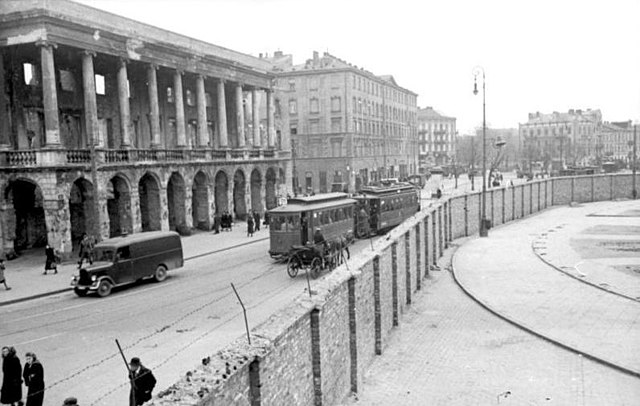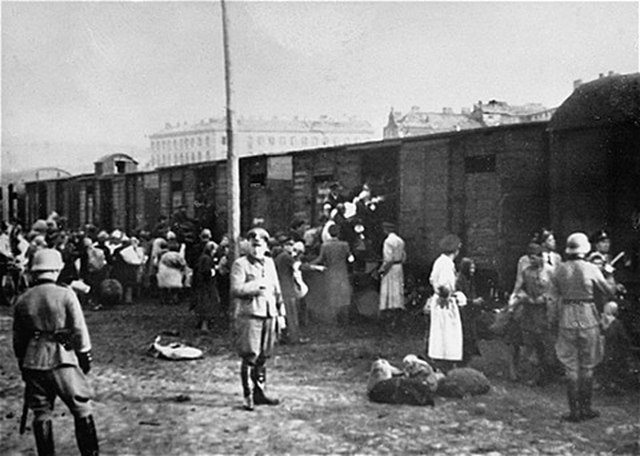Umschlagplatz was the term used during The Holocaust to denote the holding areas adjacent to railway stations in occupied Poland where Jews from ghettos were assembled for deportation to Nazi death camps. The largest collection point was in Warsaw next to the Warsaw Ghetto. In 1942 between 254,000 – 265,000 Jews passed through the Warsaw Umschlagplatz on their way to the Treblinka extermination camp during Operation Reinhard, the deadliest phase of the Holocaust in Poland. Often those awaiting the arrival of Holocaust trains, were held at the Umschlagplatz overnight. Other examples of Umschlagplatz include the one at Radogoszcz station - adjacent to the Łódź Ghetto - where people were sent to Chełmno extermination camp and Auschwitz.
National monument at the Ghetto's former Umschlagplatz symbolizing an open freight car, Stawki Street, Warsaw
Polish Jews loaded onto trains at the Warsaw Ghetto
Waiting to be deported at the Umschlagplatz.
Jews captured during the Warsaw Ghetto Uprising being led to Umschlagplatz via Zamenhof street.
The Warsaw Ghetto was the largest of the Nazi ghettos during World War II and the Holocaust. It was established in November 1940 by the German authorities within the new General Government territory of occupied Poland. At its height, as many as 460,000 Jews were imprisoned there, in an area of 3.4 km2 (1.3 sq mi), with an average of 9.2 persons per room, barely subsisting on meager food rations. Jews were deported from the Warsaw Ghetto to Nazi concentration camps and mass-killing centers. In the summer of 1942, at least 254,000 ghetto residents were sent to the Treblinka extermination camp during Großaktion Warschau under the guise of "resettlement in the East" over the course of the summer. The ghetto was demolished by the Germans in May 1943 after the Warsaw Ghetto Uprising had temporarily halted the deportations. The total death toll among the prisoners of the ghetto is estimated to be at least 300,000 killed by bullet or gas, combined with 92,000 victims of starvation and related diseases, the Warsaw Ghetto Uprising, and the casualties of the final destruction of the ghetto.

Brick wall of the Warsaw Ghetto dividing the Iron-Gate Square, with view of bombed out Lubomirski Palace (left) on the "Aryan" side of the city, May 24, 1941.
Karmelicka Street 11 from Nowolipia September/October 1939
Aerial photograph of the northern Warsaw Ghetto area after its destruction, probably 1944
Roundup of Jewish men for forced labor by the Order Police battalions, Krakowskie Przedmieście, March 1940








